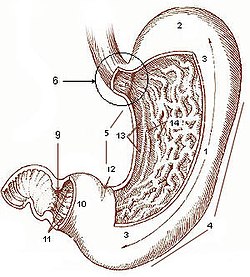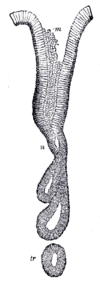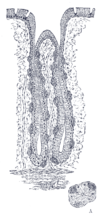This is an old revision of this page, as edited by Rodsan18 (talk | contribs) at 19:16, 20 October 2007 (tl:Sikmura). The present address (URL) is a permanent link to this revision, which may differ significantly from the current revision.
Revision as of 19:16, 20 October 2007 by Rodsan18 (talk | contribs) (tl:Sikmura)(diff) ← Previous revision | Latest revision (diff) | Newer revision → (diff)| Stomach | |
|---|---|
 The location of the stomach in the body. The location of the stomach in the body. | |
 Diagram from cancer.gov: Diagram from cancer.gov:* 1. Body of stomach * 2. Fundus * 3. Anterior wall * 4. Greater curvature * 5. Lesser curvature * 6. Cardia * 9. Pyloric sphincter * 10. Pyloric antrum * 11. Pyloric canal * 12. Angular notch * 13. Gastric canal * 14. Rugal folds Work of the United States Government | |
| Details | |
| Nerve | celiac ganglia, vagus |
| Lymph | celiac preaortic lymph nodes |
| Identifiers | |
| Latin | Ventriculus |
| Greek | Gaster |
| MeSH | D013270 |
| TA98 | A05.5.01.001 |
| TA2 | 2901 |
| FMA | 7148 |
| Anatomical terminology[edit on Wikidata] | |
In anatomy, the stomach is a bean-shaped hollow muscular organ of the gastrointestinal tract involved in the second phase of digestion, following mastication. The word stomach is derived from the Latin stomachus, which derives from the Greek word stomachos (Template:Polytonic). The words gastro- and gastric (meaning related to the stomach) are both derived from the Greek word gaster (Template:Polytonic).
Functions
The stomach is a highly acidic environment due to gastric acid production and secretion which produces a luminal pH range usually between 1 and 4 depending on the species, food intake, time of the day, drug use, and other factors. Combined with digestive enzymes, such an environment is able to break down large molecules (such as from food) to smaller ones so that they can eventually be absorbed from the small intestine. The human stomach can produce and secrete about 2 to 3 liters of gastric acid per day with basal secretion levels being typically highest in the evening.
Pepsinogen is secreted by chief cells and turns into pepsin under low pH conditions and is a necessity in protein digestion.
Absorption of vitamin B12 from the small intestine is dependent on conjugation to a glycoprotein called intrinsic factor which is produced by parietal cells of the stomach.
Other functions include absorbing some ions, water, and some lipid soluble compounds such as alcohol, aspirin, and caffeine.
Another function of the stomach is simply a food storage cavity.
Anatomy of the human stomach
The stomach lies between the esophagus and the duodenum (the first part of the small intestine). It is on the left side of the abdominal cavity. The top of the stomach lies against the diaphragm. Lying beneath the stomach is the pancreas, and the greater omentum which hangs from the greater curvature.
Two smooth muscle valves, or sphincters, keep the contents of the stomach contained. They are the esophageal sphincter (found in the cardiac region) dividing the tract above, and the Pyloric sphincter dividing the stomach from the small intestine.
The stomach is surrounded by parasympathetic (stimulant) and orthosympathetic (inhibitor) plexuses (anterior gastric, posterior, superior and inferior, celiac and myenteric), which regulate both the secretory activity and the motor activity of the muscles.
In humans, the stomach has a volume of about 50 mL when empty. After a meal, it generally expands to hold about 1 liter of food, but it can actually expand to hold as much as 4 liter. When drinking milk it can expand to just under 6 pints, or 3.4 liter.
Sections
The stomach is divided into four sections, each of which has different cells and functions. The sections are:
| Cardia | Where the contents of the esophagus empty into the stomach. |
| Fundus | Formed by the upper curvature of the organ. |
| Body or corpus | The main, central region. |
| Pylorus or antrum | The lower section of the organ that facilitates emptying the contents into the small intestine. |
Blood supply
The lesser curvature of the stomach is supplied by the right gastric artery inferiorly, and the left gastric artery superiorly, which also supplies the cardiac region. The greater curvature is supplied by the right gastroepiploic artery inferiorly and the left gastroepiploic artery superiorly. The fundus of the stomach, and also the upper portion of the greater curvature, are supplied by the short gastric artery
Histology of the human stomach
Layers
Like the other parts of the gastrointestinal tract, the stomach walls are made of the following layers, from inside to outside:
| mucosa | The first main layer. This consists of an epithelium, the lamina propria underneath, and a thin layer of smooth muscle called the muscularis mucosae. |
| submucosa | This layer lies under the mucosa and consists of fibrous connective tissue, separating the mucosa from the next layer. The Meissner's plexus is in this layer. |
| muscularis externa |
Under the submucosa, the muscularis externa in the stomach differs from that of other GI organs in that it has three layers of smooth muscle instead of two.
|
| serosa | This layer is under the muscularis externa, consisting of layers of connective tissue continuous with the peritoneum. |


Glands
The epithelium of the stomach forms deep pits. The glands at these locations are named for the corresponding part of the stomach:
| Cardiac glands (at cardia) |
Pyloric glands (at pylorus) |
Fundic glands (at fundus) |
 |
 |

|
Different types of cells are found at the different layers of these glands:
| Layer of stomach | Name | Secretion | Region of stomach | Staining |
| Isthmus of gland | goblet cells | mucus gel layer | Fundic, cardiac, pyloric | Clear |
| Neck of gland | parietal (oxyntic) cells | gastric acid and intrinsic factor | Fundic, cardiac, pyloric | Acidophilic |
| Base of gland | chief (zymogenic) cells | pepsinogen, rennin | Fundic only | Basophilic |
| Base of gland | enteroendocrine (APUD) cells | hormones | Fundic, cardiac, pyloric | - |
Control of secretion and motility
The movement and the flow of chemicals into the stomach are controlled by both the autonomic nervous system and by the various digestive system hormones:
| Gastrin | The hormone gastrin causes an increase in the secretion of HCl, pepsinogen and intrinsic factor from parietal cells in the stomach. It also causes increased motility in the stomach. Gastrin is released by G-cells in the stomach to distenstion of the antrum, and digestive products. It is inhibited by a pH normally less than 4 (high acid), as well as the hormone somatostatin. |
| Cholecystokinin | Cholecystokinin (CCK) has most effect on the gall bladder, but it also decreases gastric emptying. |
| Secretin | In a different and rare manner, secretin, produced in the small intestine, has most effects on the pancreas, but will also diminish acid secretion in the stomach. |
| Gastric inhibitory peptide | Gastric inhibitory peptide (GIP) decreases both gastric acid and motility. |
| Enteroglucagon | enteroglucagon decreases both gastric acid and motility. |
Other than gastrin, these hormones all act to turn off the stomach action. This is in response to food products in the liver and gall bladder, which have not yet been absorbed. The stomach needs only to push food into the small intestine when the intestine is not busy. While the intestine is full and still digesting food, the stomach acts as storage for food.
Diseases of the stomach
- Dyspepsia
- Stomach ache
- Peptic ulcer
- Achlorhydria
- Hypochlorhydria
- Linitis plastica
- Zollinger-Ellison syndrome
- Gastroparesis
- GERD
- Borborygmus
Historically, it was widely believed that the highly acidic environment of the stomach would keep the stomach immune from infection. However, a large number of studies have indicated that most cases of stomach ulcers, gastritis, and stomach cancer are caused by Helicobacter pylori infection. One of the ways it is able to survive in the stomach involves its urease enzymes which metabolize urea (which is normally secreted into the stomach) to ammonia and carbon dioxide which neutralizes gastric acid and thus prevents its digestion. In recent years, it has been discovered that other Helicobacter bacteria are also capable of colonizing the stomach and have been associated with gastritis.
Having too little or no gastric acid is known as hypochlorhydria or achlorhydria respectively and are conditions which can have negative health impacts. Having high levels of gastric acid is called hyperchlorhydria. Many people believe that hyperchlorhydria can cause stomach ulcers. However, recent research indicates that the gastric mucosa which secretes gastric acid is acid-resistant.
Differences among animals
In ruminants, such as bovines, the stomach is a large multichamber organ which hosts symbiotic bacteria that produce enzymes required for the digestion of cellulose from plant matter, primarily cellulase. The partially digested plant matter passes through each of the intestine chambers in sequence, being regurgitated and rechewed at least once in the process.
In some animals (such as cats and dogs), the pH of the lumen is lower, usually between 1 and 2. In contrast, the human stomach pH is usually between 1 and 3.
References
- Template:GeorgiaPhysiology
- stomach at The Anatomy Lesson by Wesley Norman (Georgetown University)
- Sherwood, Lauralee (2004) Human Physiology - From Cells to Systems (International Student Edition, 5th ed) p604 Books/Cole - Thomson Learning ISBN 0-534-39536-8
- Saladin, Kenneth S. (2004) "Anatomy & Physiology - The Unity of Form and Function" (International Edition, 3rd ed) p950 - The McGraw Hill Companies ISBN 0-07-242903-8
External links
- Digestion of proteins in the stomach
- Template:McGrawHillAnimation
- Site with details of how ruminants process food
- Interview with Dr. Jerome Groopman, Highlight at 2:30
| Anatomy of the gastrointestinal tract, excluding the mouth | |||||||||||||||||||||
|---|---|---|---|---|---|---|---|---|---|---|---|---|---|---|---|---|---|---|---|---|---|
| Upper |
| ||||||||||||||||||||
| Lower |
| ||||||||||||||||||||
| Wall | |||||||||||||||||||||